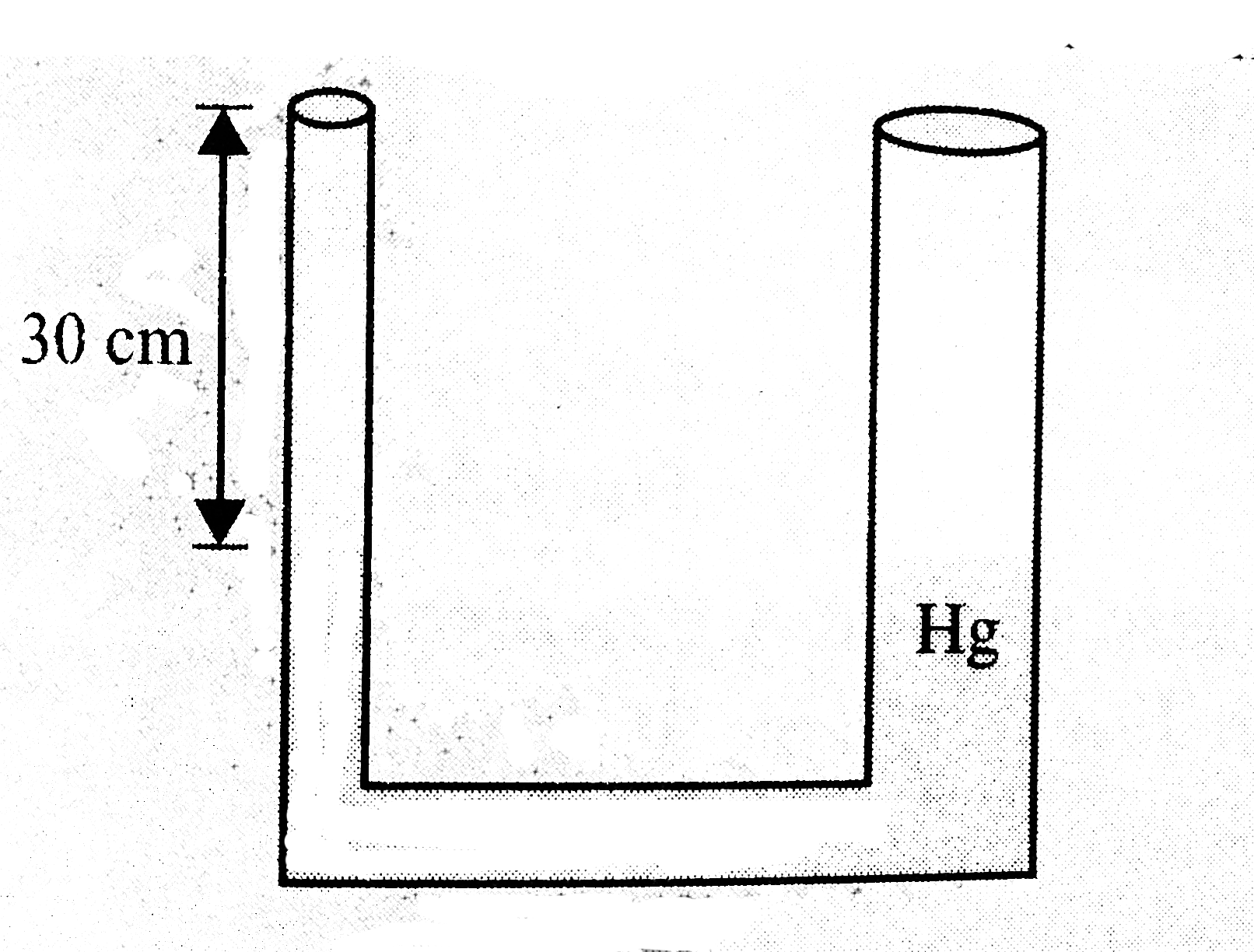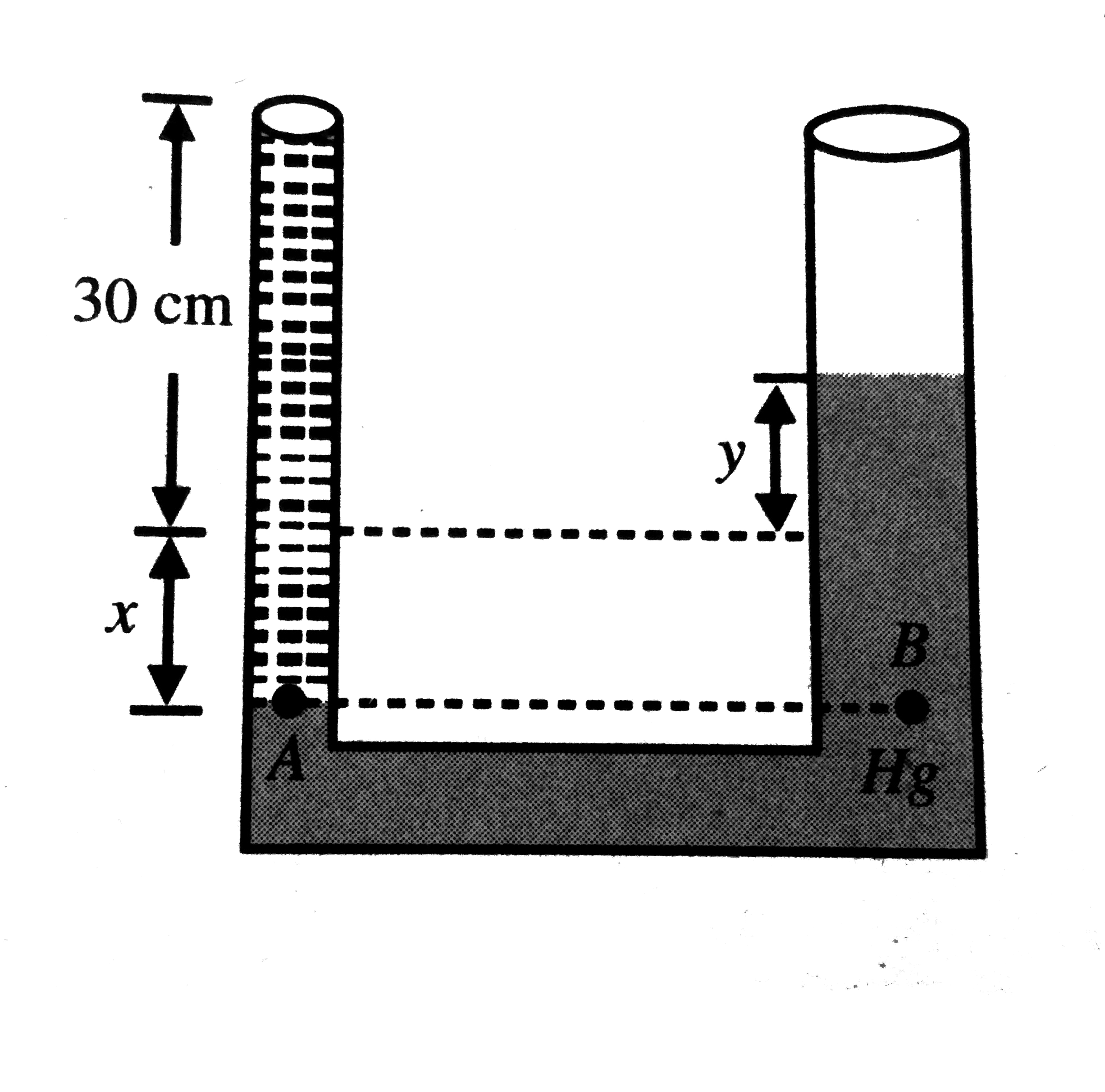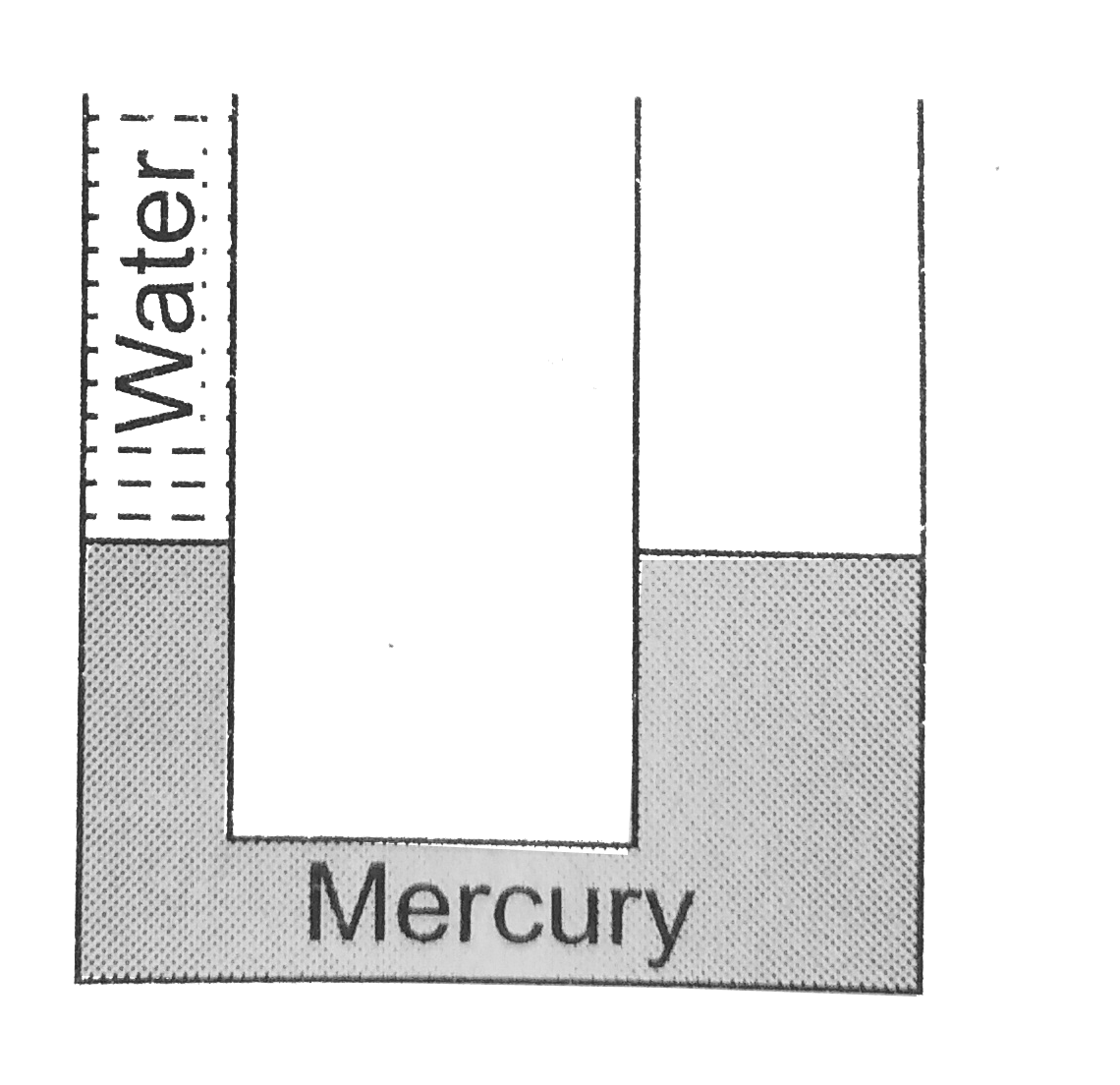A U-tube in which the cross-sectional area of the limb on the left is one-third of the limb on the right contains mercury (density 13.6g/cm3). The level of mercury in the narrow limb extends to a distance of 30cm from the upper end of the tube. What will be the rise in the level of mercury in the right limb, if the left limb is filled to the top with water (neglect surface tension effects)?

Suppose area of cross section narrow limb be a then area of cross section of right limb will be 3a

Let the level of mercury in left limb fall be x and the rise of level in right limb be y, then
ax=(3a)y
x=3y
According to Pascal's law, PA=PB
(30×x)ρwg=(x+y)ρHgg
(30×3y)×1×g=(3y=y)×13.6×g
y=0.58cm
Topper's Solved these Questions
- BOOK - CENGAGE PHYSICSCHAPTER - FLUID MECHANICSEXERCISE - Exercise 4.211videos
FLUID MECHANICS
- BOOK - CENGAGE PHYSICSCHAPTER - FLUID MECHANICSEXERCISE - Exercise 4.310videos
FLUID MECHANICS
- BOOK - CENGAGE PHYSICSCHAPTER - FLUID MECHANICSEXERCISE - Solved Examples7videos
FLUID MECHANICS
- BOOK - CENGAGE PHYSICSCHAPTER - DIMENSIONS & MEASUREMENTEXERCISE - Integer2videos
DIMENSIONS & MEASUREMENT
- BOOK - CENGAGE PHYSICSCHAPTER - GRAVITATIONEXERCISE - INTEGER_TYPE1videos
GRAVITATION
Similar Questions
Mercury is poured into a U-tube in which the cross-sectional area of the left-hand limb is three times smaller than that of the right one. The level of the mercury in the narrow limb is a distandce l=30cm from the upper end of the tube. How much will the mercury level rise in the right-hand limb if the left one is filled to the top with water?
View SolutionBoth limbs of a 'U' tube are of equal length. One of the limbs is sealed and contains a column of 28 cm of air at atmospheric pressure. The air is separated from the atmosphere by mercury. What will be the height of air in the sealed limb, if the other limb is now filled to the top with mercury ? Atmospheric pressure is 76 cm of mercury.
View Solution
Knowledge Check
- Question 1 - Select One
A U -tube in which the cross - sectional area of the limb on the left is one quarter, the limb on the right contains mercury (density13.6g/cm3). The level of mercury in the narrow limb is at a distance of 36 cm from the upper end of the tube. What will be the rise in the level of mercury in the right limb if the left limb is filled to the top with water ?
 A1.2 cmB2.35 cmC0.56 cmD0.8 cm
A1.2 cmB2.35 cmC0.56 cmD0.8 cm - Question 2 - Select One
Which one is bone of fore limb ?
AHumerusBFemurCTibiaDFibula. - Question 3 - Select One
Arrange the following steps in proper sequence to determine the pressure exerted by a gas enclosed in a container using a manometer.
(A) Connect one end of the manometer to the container filled with gas.
(B) Both the limbs of the manometer are exposed to air, mercury level in both the limbs are equal due to atmospheric pressure
(C) Determine the difference in level of the mercury in both the limbs of the manometer (t).
(D) If the level of the mercury in the limb connected to the container is above the mercury level in the limb exposed to air, the pressure of the gas in the container is determined as atmospheric pressure - l
(E) If the level of the mercury in the limb connected to the container is above the mercury level in the limb exposed to air, the pressure of the gas in the container is determined as atmospheric pressure +l
(F) Note the level of the mercury in the limbs of the monometer.AA B C E F EBE B A D C FCB A C F D EDB C D A F E
The lower end of a capillary tube is immersed in mercury. The level of mercury in the tube is found to be 2 cm below the outer level. If the same tube is immersed in water, up to what height will the water rise in the capillary ?
View SolutionA manometer tube contains mercury of density 13.6×103 kg m−3. What difference in the levels of mercury in the two arms is indicated by a gauge pressure of 1.03×105Pa?
View SolutionWhen one limb of a manometer is connected to a container filled with a gas, the level of the mercury in the other limb rises by 'h' cm. Then the pressure of the gas in the container is 76+h cm of Hg.
View SolutionA gas is filled into a bulb connected to an open limb manometer. The level of mercury in the open arm is 2.1 cm lower than that in the other arm of the manometer. The atmospheric pressure is 740 mm. What is the pressure of the gas?
View SolutionArrange the following steps in proper sequence to determine the pressure exerted by a gas enclosed in a container using a manometer.
(a)Connect one end of the manometer to the container filled with gas.
(b)Both the limbs of the manometer are exposed to air, mercury level in both the limbs are equal due to atmospheric pressure.
(c )Determine the difference in level of the mercury in both the limbs of the manometer (l).
(d) If the level of the mercury in the limb connected to the container is above the mercury level in the limb exposed to air, the pressure of the gas in the container is determined as atmospheric pressure -l.
(e ) If the level of the mercury in the limb connected to the container is below the mercury level in the limb exposed to air, the pressure of the gas in the container is determined as atmospheric pressure +l.
(f) Note the level of the mercury in the limbs of the manometer.View Solution

